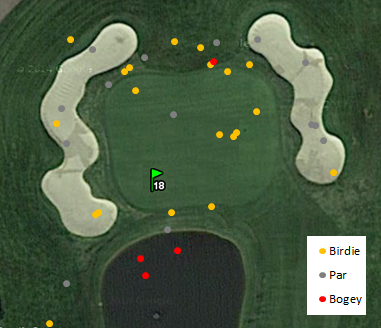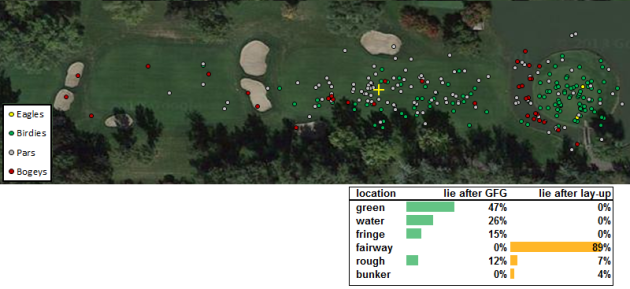After a final round where the winner was in doubt throughout, Jason Day emerged as the winner of the four man playoff to win at Torrey Pines. Day went for the green in two at 18 in regulation and again in the playoff, making par the first time to stay at -9 and making birdie the second time advance in the playoff. Runner-up J.B. Holmes did not go for the green in regulation, and after a good wedge in, missed a downhill birdie putt to win. The immediate reaction from myself & others on Twitter was that Holmes should have gone for the green because it gave him a better chance at birdie. I’ll try to provide some context to why he played a lay-up and also what the numbers say in that situation.
Day’s Win
This was Jason Day’s first stroke play win since 2010. Day’s been generating monster performances now for the last two seasons – despite injuries sapping much of 2014 – and he’s always looked right on the edge of something truly special. Perhaps that starts this season. Day’s game is built around his effortless power off the tee, but on these tough courses his short game really shines through. He scrambles with the best on Tour and his putting is outstanding; that gives him something to lean back on when the field is only hitting ten greens a round. He hit some ridiculously good shots on Sunday tee to green, but he was also 5/5 in scrambling. He talked about how he “liked to grind it out” in his post-tournament presser. I’m not sure there’s anyone else better at doing that right now.
This sets Day up for an enormous year. Right now, he’s in that elite group at the very top who are the favorites whenever the big guns tee it up together.
Going for the 18th in Two
J.B. Holmes sat in the middle of the fairway on 18 at -9, with 235 yards to the pin. Scott Stallings and Day were in the clubhouse at -9 and Harris English could get to -9 as well with a birdie on 18. Holmes needed a birdie to win outright; a par would only earn him a 1/3 or 1/4 shot in a playoff – with the defending champion and another clearly superior player. Holmes eventually chose to lay up, claiming the lie wasn’t ideal and that he was afraid he’d hook it long and left. With the lay-up, Holmes still had about a 1/4 chance of birdie. He spun a wedge to 19 feet and rolled his birdie putt just past.
On a typical par 5, it would be lunacy not to go for the green from 235 yards in the fairway. Tour pros go for that shot about 90% of the time and are rewarded with birdie about 55% of the time. 18 at Torrey Pines seems like an atypical par 5 though. Hit enough club to carry the water just short of the pin and you risk rolling it into the thick rough long. That earns a wicked downhill chip that (as we saw with Jason Day) brings the water into play. The question becomes, does going for the green in two earn a significantly better chance at birdie, at least enough to outweigh the chance of making a bogey by hitting it into the water either on the 2nd shot or the 3rd shot.
Based on data from Sunday, 17 pros went for the 18th in two shots. Eight players made birdie, eight made par, and one made bogey after a three putt. That 47% birdie rate right there is pretty damning to Holmes’s decision. The positions those 17 players attacked the green from were very similar to Holmes – an average of 239 yards to the pin and 14/17 in the fairway. In fact, Holmes was one of only three guys to lay up from inside 245 yards in the fairway all day. Last year, 12/21 players (57%) made birdie after going for it in two. It seems like a reasonable assumptions that the result of Holmes’s 2nd shot would be similar to those 38 other players who went for it from similar positions. I could also adjust the expectations based on Holmes’s ability on long approach shots vs. wedge shots, but he’s equal on those based on my shot by shot numbers from the past year.
I’ve plotted the results from 2014 & 2015 below. Birdies in gold, bogeys in red. Hitting the green yielded birdie 6/7 times, long in the rough yielded birdie 6/11 times, long left yielded birdie 2/5 times, short left 3/4 times, right of the green 1/5 times, and short of the green 2/6 times with three water balls. In short, pretty much anywhere Holmes hit his 2nd shot he was more likely to make birdie than with a wedge from 100 yards. And only one player out of 35 who carried the water made bogey.

I think it’s pretty clear Holmes made the wrong play here. Making tactical errors in situations like this are very common on Tour because players get fixated on the information that easily comes to mind – I’ve hooked long approach shots before, Lucas Glover hit the water right before me, I hit a wedge to 10 feet last year (which Holmes did to this pin position). They fail to realize that a handful of shots provide far less information than the results of the other 155 players in the field. The outcomes of the 38 guys who went for the green in two over the past two years provides FAR more information about the possible outcomes of your own shot.
Part of using numbers in golf is knowing what is likely to happen if you hit an average shot from a given lie and distance. While the differences between Tour players may seem magnified in terms of outcomes (money, wins, FedEx points), they’re all within in pretty narrow range of golfing ability. This means you can generalize potential outcomes for most shots similarly to what I’ve done above and choose a strategy from there.
In Holmes’s case, he went from nearly 50% to birdie if he went for the green to about 25% to birdie by laying-up. I have him at above 60% to win if he goes for the green and about 48% to win if he lays up. In terms of earnings, he cost himself about $100,000 by laying up.
Here is the data for all those who went for the green in two on 18 in 2014 & 2015



Recent Comments